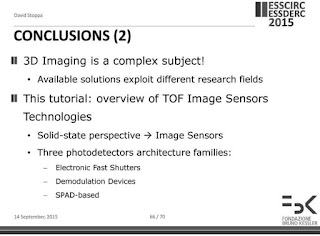SeekingAlpha publishes Sony quarterly earnings call transcript. Few quotes on the company's image sensor and camera module business status:
"We believe that demand for our devices could decelerate in the near term. In our image sensor business, we have changed our forecast to assume a slowdown in the growth of the market for smartphones. In fact, there's a risk that the market for high-end smartphones might decrease due to the issue in emerging markets I just mentioned.
In light of this situation, the management team of Sony is taking quick action. We have instructed our sales team to more aggressively approach smartphone makers, particularly those we had to turn away last year when we were supply-constrained. We have made the decision to postpone our plan to reach production capacity of 87,000 wafers per month by the end of September 2016.
Finally, we are seriously considering utilizing a portion of our facility in Oita we bought from Toshiba to manufacture logic instead of photodiodes which could lead to a reduction in the cost of our sensors. Although we are taking these actions so as to mitigate the downsized rate in this business, we are confident that in the long-term prospects of image sensors, because we think there is room to expand their use in [indiscernible] cameras, automobiles and the Internet of Things.
We also believe that one of our competitive advantage in the image sensor space comes from the fact that we manufacture the sensor in-house. Thus, we believe that the investments we have made in production capacity for sensors will be variable going forward."
"The possibility that we might have to impair assets in our camera module business comes from problems we had when we're starting up this business. And the decrease in projected future demand from high-end smartphone makers."
"Last fiscal year, we received larger orders than expected in image sensor business. This cause our ability to supply the market to be constrained, a situation that continued through the beginning of current fiscal year.
Then, in the summer of 2015, we had an issue with our production equipment, which resulted in our having to decline orders from the 13 customers. After we resolved this production issue and after new capacity had just come online orders from our customers started to decline due to softer end-user demand for smartphones.
Further complicating matters were the fact that we supply custom design sensors to some of our major customers, and there is an approximately five-month lead time to manufacture our sensors. As a result, it is difficult to switch our products in line over the other customers quickly. We believe that image sensor business will start to recover from the first quarter of next fiscal year, but we will formulate our business plan based on an assumption that growth of the smartphone market will slow."
Quotes from Q&A sennsion:
"Well, we expect to make some recovery in first quarter in fiscal year 2016 because we already have orders for that. And as I said, we are expecting now almost no growth in the smartphone market. So, I think we are currently conservative about the prospect of the fiscal year 2016.
However, currently, we are aggressively doing the promotion of the image sensor business particularly for the Chinese player which we lost when our production is constrained. So, at this moment, we are in the middle of the budget process. So I cannot specify the prize of worrying over utilization as this point in time."
"Well, in capacity, we have a plan to increase our capacity to 87,000 by September this year and approximately 20% of that capacity increase here so-called half portion. So, currently we are evaluating the current production and I think the production adjustment would be quite concentrated in that 20% portion. However, we haven't decided whether we will reduce or we will change the current planned expansion [indiscernible] at this point in time."
"Well, for next year, our so-called dual lens – dual camera platform will be launched by, we believe, from major smartphone players. However, as I said previously, recently, our smartphone market is growing and particularly, our high-end smartphone market is now slowing down. So, that may impact the demand or production schedule of dual camera smartphones by the major smartphone manufacturers. So, we believe the real start, the takeoff of smartphone with dual lens camera will be in the year of 2017."
"And as for the modules, as you may know, we are a newcomer in this business. And two years ago, we started this business. However, at the beginning, we had failed to supply the initial product. And after that, we are gradually improving our production itself. And now we are keeping very high yield level. At this moment, the forecast for the smartphone business itself is now declining. That's why we explained about the possibility of the impairment of the module.
And as for the size or timing of the impairment of the module, at this point in time, we cannot comment on that. But as Takeda-san said, approximately a little bit less than 15% of the Device asset is in module."
"We believe that demand for our devices could decelerate in the near term. In our image sensor business, we have changed our forecast to assume a slowdown in the growth of the market for smartphones. In fact, there's a risk that the market for high-end smartphones might decrease due to the issue in emerging markets I just mentioned.
In light of this situation, the management team of Sony is taking quick action. We have instructed our sales team to more aggressively approach smartphone makers, particularly those we had to turn away last year when we were supply-constrained. We have made the decision to postpone our plan to reach production capacity of 87,000 wafers per month by the end of September 2016.
Finally, we are seriously considering utilizing a portion of our facility in Oita we bought from Toshiba to manufacture logic instead of photodiodes which could lead to a reduction in the cost of our sensors. Although we are taking these actions so as to mitigate the downsized rate in this business, we are confident that in the long-term prospects of image sensors, because we think there is room to expand their use in [indiscernible] cameras, automobiles and the Internet of Things.
We also believe that one of our competitive advantage in the image sensor space comes from the fact that we manufacture the sensor in-house. Thus, we believe that the investments we have made in production capacity for sensors will be variable going forward."
"The possibility that we might have to impair assets in our camera module business comes from problems we had when we're starting up this business. And the decrease in projected future demand from high-end smartphone makers."
"Last fiscal year, we received larger orders than expected in image sensor business. This cause our ability to supply the market to be constrained, a situation that continued through the beginning of current fiscal year.
Then, in the summer of 2015, we had an issue with our production equipment, which resulted in our having to decline orders from the 13 customers. After we resolved this production issue and after new capacity had just come online orders from our customers started to decline due to softer end-user demand for smartphones.
Further complicating matters were the fact that we supply custom design sensors to some of our major customers, and there is an approximately five-month lead time to manufacture our sensors. As a result, it is difficult to switch our products in line over the other customers quickly. We believe that image sensor business will start to recover from the first quarter of next fiscal year, but we will formulate our business plan based on an assumption that growth of the smartphone market will slow."
Quotes from Q&A sennsion:
"Well, we expect to make some recovery in first quarter in fiscal year 2016 because we already have orders for that. And as I said, we are expecting now almost no growth in the smartphone market. So, I think we are currently conservative about the prospect of the fiscal year 2016.
However, currently, we are aggressively doing the promotion of the image sensor business particularly for the Chinese player which we lost when our production is constrained. So, at this moment, we are in the middle of the budget process. So I cannot specify the prize of worrying over utilization as this point in time."
"Well, in capacity, we have a plan to increase our capacity to 87,000 by September this year and approximately 20% of that capacity increase here so-called half portion. So, currently we are evaluating the current production and I think the production adjustment would be quite concentrated in that 20% portion. However, we haven't decided whether we will reduce or we will change the current planned expansion [indiscernible] at this point in time."
"Well, for next year, our so-called dual lens – dual camera platform will be launched by, we believe, from major smartphone players. However, as I said previously, recently, our smartphone market is growing and particularly, our high-end smartphone market is now slowing down. So, that may impact the demand or production schedule of dual camera smartphones by the major smartphone manufacturers. So, we believe the real start, the takeoff of smartphone with dual lens camera will be in the year of 2017."
"And as for the modules, as you may know, we are a newcomer in this business. And two years ago, we started this business. However, at the beginning, we had failed to supply the initial product. And after that, we are gradually improving our production itself. And now we are keeping very high yield level. At this moment, the forecast for the smartphone business itself is now declining. That's why we explained about the possibility of the impairment of the module.
And as for the size or timing of the impairment of the module, at this point in time, we cannot comment on that. But as Takeda-san said, approximately a little bit less than 15% of the Device asset is in module."














































